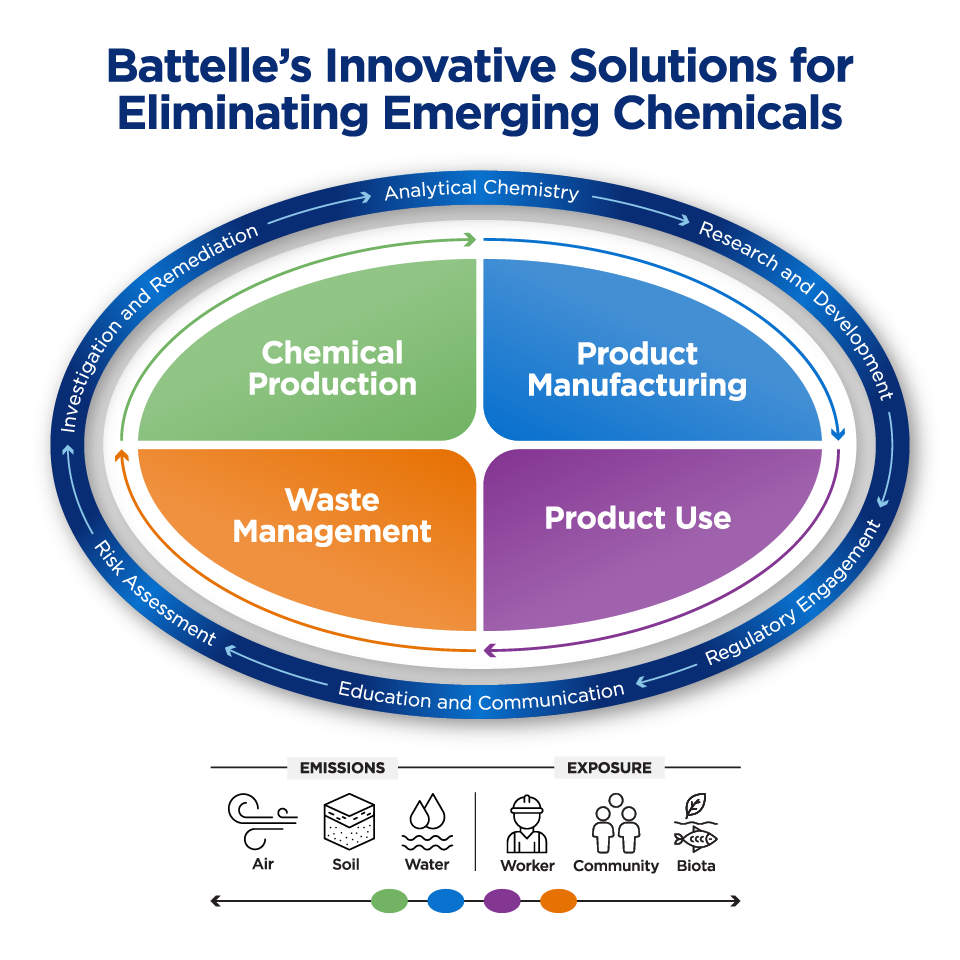Phasing Out “Forever Chemicals”: Finding Alternatives for PFAS

Per- and polyfluoroalkyl substances (PFAS) are found in many industrial and consumer products, from firefighting foams to cosmetics to outdoor clothing. However, rising health and environmental concerns and regulatory requirements are putting pressure on companies to remove PFAS chemicals from their products, packaging, supply chains and waste streams. Battelle is at the forefront of PFAS response, with solutions for PFAS risk mitigation and management, treatment and replacement.

What Are PFAS Chemicals?
PFAS are synthetic chemicals developed more than 70 years ago. PFAS have many useful properties that impart water repellence, oil repellence, heat resistivity and surfactant qualities. Because of these properties, PFAS have been used in a multitude of applications, from weatherproof clothing, furniture and adhesives to food packaging, non-stick cookware and insulation in electrical wires. Depending on how you define them, there are somewhere between 15,000 and 900,000 chemicals included in the class. Some of the earliest synthesized and best-known PFAS chemicals include perfluorooctanoic acid (PFOA) and perfluorooctane sulfonate (PFOS), both the focus of initial regulatory efforts in the U.S., EU and other parts of the world.
The unique properties of PFAS chemicals come from their carbon-fluorine (C-F) bonds, which are among the strongest bonds existing in organic chemistry. These bonds very rarely exist in nature—and they don’t break down in nature, either. That’s why PFAS are often known as “forever chemicals.” The strength of the C-F bonds makes PFAS exceptionally resistant to degradation; they do not easily break down under environmental conditions, whether it be heat, sunlight or microbial activity. This persistence leads to their accumulation in the environment, where they can remain for decades. Due to this, PFAS have been widely detected in water, soil and air, as well as in the tissues of wildlife and humans globally. Studies have linked exposure to certain PFAS with a variety of health issues, including reproductive and developmental effects, reduced immune response, and some types of cancer.
PFAS enter the environment through various pathways, including industrial emissions and waste streams and product use and disposal. Historically, firefighting foams known as aqueous film-forming foams (AFFFs)—often containing PFOA and PFOS—have been identified as a significant source of groundwater and drinking water contamination, especially around military bases and airports. Products containing PFAS that are disposed of in landfills can leach PFAS into the surrounding soil and groundwater. PFAS also winds up in wastewater treatment plants via residential, commercial and industrial sources. While these facilities remove many contaminants, they are not specifically designed to remove PFAS, resulting in the release of PFAS-contaminated effluent into water bodies and the spread of PFAS through biosolids applied to agricultural fields.
The Push to Phase Out PFAS
Due to the environmental and health concerns with PFAS chemicals, companies are facing increasing pressure to remove PFAS from products and minimize their environmental impact. The push to phase out PFAS comes from several fronts.
Emerging Regulations
In the last five years, PFAS regulations have grown exponentially across the globe in a way that we have not seen as expeditiously for any other chemical class. In April 2024, the U.S. Environmental Protection Agency (EPA) finalized a rule designating PFOA and PFOS as hazardous substances under the Comprehensive Environmental Response, Compensation, and Liability Act (CERCLA). At the same time, under the Safe Drinking Water Act (SDWA), EPA also set a national, legally enforceable drinking water standard for PFOA, PFOS and three other PFAS chemicals. Five months earlier, the EPA finalized reporting and recordkeeping requirements for PFAS under the Toxic Substances Control Act (TSCA), requiring any person that manufactures (including import) or has manufactured (including imported) PFAS or PFAS-containing articles in any year since January 1, 2011, to electronically report information regarding PFAS uses, production volumes, disposal, exposures and hazards. These regulations come on the heels of other actions taken at both the federal and state levels to address PFAS risks. At the same time, the European Registration, Evaluation, Authorization and Restriction of Chemicals (REACH) proposal seeks to ban the entire PFAS class of chemicals from commerce in the EU. Manufacturers and raw materials suppliers now face a quickly evolving patchwork of regulatory actions at the state, national and international levels.
Litigation and Legal Liability
Since 1999, more than 9,800 PFAS complaints have been filed in 123 courts, naming 357 companies operating in 140 industries. Many industries are bracing for a wave of new litigation as public awareness of PFAS contamination grows and new regulations take force.
Stakeholder Pressure
Consumers and investors are also adding to the pressure on companies to phase out PFAS. In 2022, investors managing more than US $8 trillion united to call on the world’s biggest chemical producers to phase out the chemical class. Consumers are also increasingly aware of PFAS and demanding PFAS-free products.
Obsolescence and Supply Chain Disruptions
Because of growing legal and regulatory risks, some suppliers are discontinuing the manufacture of certain PFAS chemicals. One of the few primary manufacturers, 3M, plans to discontinue manufacturing all fluoropolymers, fluorinated fluids, and PFAS-based additive products by the end of 2025.

Finding PFAS Alternatives
With the unique functional properties of PFAS chemicals, finding suitable alternatives is challenging. Industry associations are working diligently to support phase-out and alternative selection across various use sectors. Government agencies have also been working to review alternatives.
- EPA has been reviewing substitutes for new chemicals under the New Chemicals Program (NCP) since 2000. Hundreds of alternatives of various types have been received and reviewed to evaluate persistence, bioaccumulation and toxicity, among other concerns, to ensure that substitutions are truly safer than the chemicals they are replacing.
- Organizations such as ChemSec have also been evaluating alternatives, with analysis of hazards, functionality, availability, cost and other life cycle considerations to support transition and provide potential alternatives.
- The Organisation for Economic Cooperation and Development (OECD) provides a framework for alternatives assessment that comprehensively supports the decision-making process for manufacturers and suppliers interested in self-assessment of PFAS risks.
- GreenScreen for Safer Chemicals provides specific “PFAS-free” alternatives for PFAS-containing products such as firefighting foam and food packaging.
- Change Chemistry is focused on accelerating the development and commercialization of innovative green and sustainable chemistry solutions and connecting leading chemical companies, brand manufacturers and large retailers to innovative startups.
Although substantial progress has been made toward PFAS-free alternatives in some industries, others (such as those with applications where PFAS is still considered essential) face substantial challenges where little progress has been made in finding effective alternatives.
Battelle’s PFAS Services: Leading the Way to a PFAS-Free Future
Battelle has provided a suite of services for PFAS risk mitigation and management, treatment and alternative assessment since 2007. From the evaluation of alternative chemistry formulations, to chemical analysis and human health exposure studies, to environmental investigation, clean-up and destruction technologies, Battelle has been supporting clients across the life cycle for almost two decades.

“We strive to support clients with sustainable solutions that shift the paradigm from reacting to emerging contaminants to proactively developing a framework for designing, engineering, and consciously using sustainable chemistries,” explains Shalene Thomas, Battelle’s Emerging Sciences Program Manager. “Our goal is to ensure that our clients are never again in the situation they may currently be in with PFAS.
We’ve had some big wins over the years, including:
- Ongoing testing and validation efforts to find replacements for PFAS-containing firefighting foams to determine if commonly available firefighting engineering technology will allow the foams to meet the required performance standards.
- PFAS Air Insight™, a novel technology to measure PFAS in ambient air, and PFAS Insight™, a passive sampling method for groundwater.
- PFAS Signature®, an innovative fingerprinting method for forensic analysis of PFAS contamination that has been applied since 2021 to differentiate between PFAS sources and establish background levels of PFAS.
- GAC RENEW™, a treatment system for removing PFAS from granulated activated carbon (GAC) vessels so PFAS can be destroyed and GAC can be reused without taking it out of the treatment system.
- PFAS ANNIHILATOR®, the first-ever closed-loop, on-site destruction technology for PFAS remediation. The technology is now being brought to scale by Revive Environmental (a spin-out of Battelle) and has been permitted for PFAS destruction in multiple states.
We’re continuing to lead the way in the development of new analytical methods, treatment and destruction approaches, and material replacement options. Our work is driving progress toward safer products, contamination-free water and food supplies, and healthier environments for both people and wildlife.
Featured Expert

Shalene Thomas, R.E.P
Sr. Emerging Contaminants Program Manager
Shalene provides thought leadership, drives R&D and service offerings for Battelle’s growing PFAS and other potential emerging contaminant programs. She has more than 25 years of experience in environmental consulting that includes 15 years of experience providing PFAS strategic management services to government and commercial clients.
Related Blogs
BATTELLE UPDATES
Receive updates from Battelle for an all-access pass to the incredible work of Battelle researchers.